Introduction
“Many men go fishing all their lives without knowing that it is not fish they are after.” – Henry David Thoreau
Fishing (also, hunting and foraging) has been part of the backcountry experience since the dawn of humanity. For some, it connects them to their ancestral roots. For others, it allows them to connect to the natural world on a more visceral level. For me, it’s both the feeling of self-reliance and a deeper appreciation of how nature nourishes us, both metaphorically and physically. In addition, I’ve always been a bit of an adrenaline junkie. And the endorphins (happy hormones) released following the adrenaline rush of catching a big, wary trout have a profound impact on my enjoyment of the backcountry.
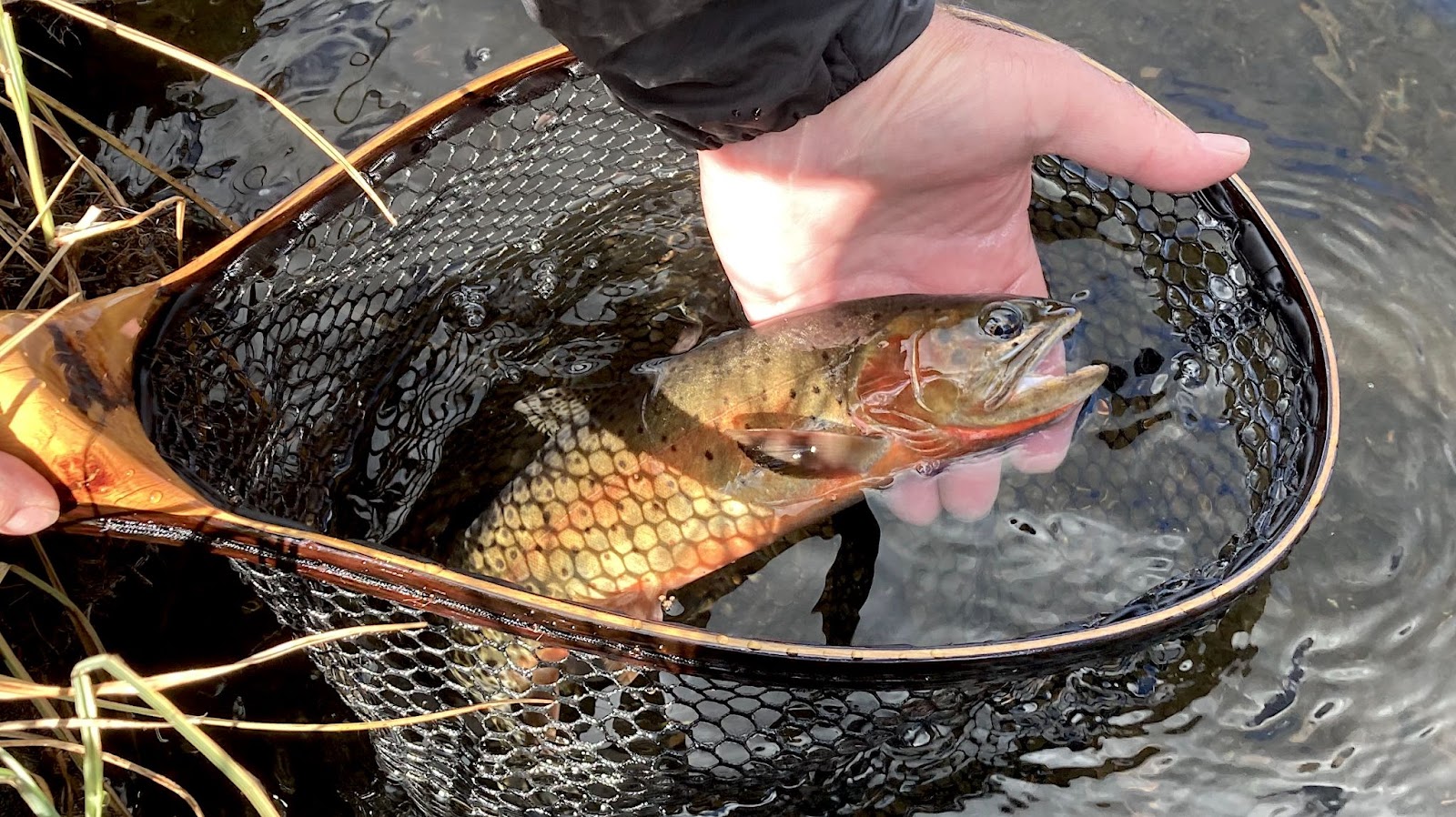
In addition to these benefits, fish are a healthy source of protein, omega-3 fatty acids, and essential vitamins and minerals. Cold water trout, in particular, have unusually high concentrations of vitamins D, E, and A, deficiencies of which can have notable impacts on the performance, recovery, and injury risk to long-distance endurance athletes (source). Admittedly, eating one or two trout per day may have a negligible impact on nutrition or performance during a short backcountry trek. However, it’s well-known that eating cold-water fish, including trout, can have profound positive impacts on one’s long-term nutritional health (assuming they were sourced from pristine and uncontaminated water sources or farms).
Consuming fresh fish in the backcountry can also provide a welcome break for the palate that’s accustomed to dehydrated, freeze-dried, pre-packaged, or processed backpacking foods. Enjoying a plate of fish tacos while watching the alpenglow fade on a nearby wilderness peak is admittedly, one of my guiltiest culinary pleasures in the backcountry.
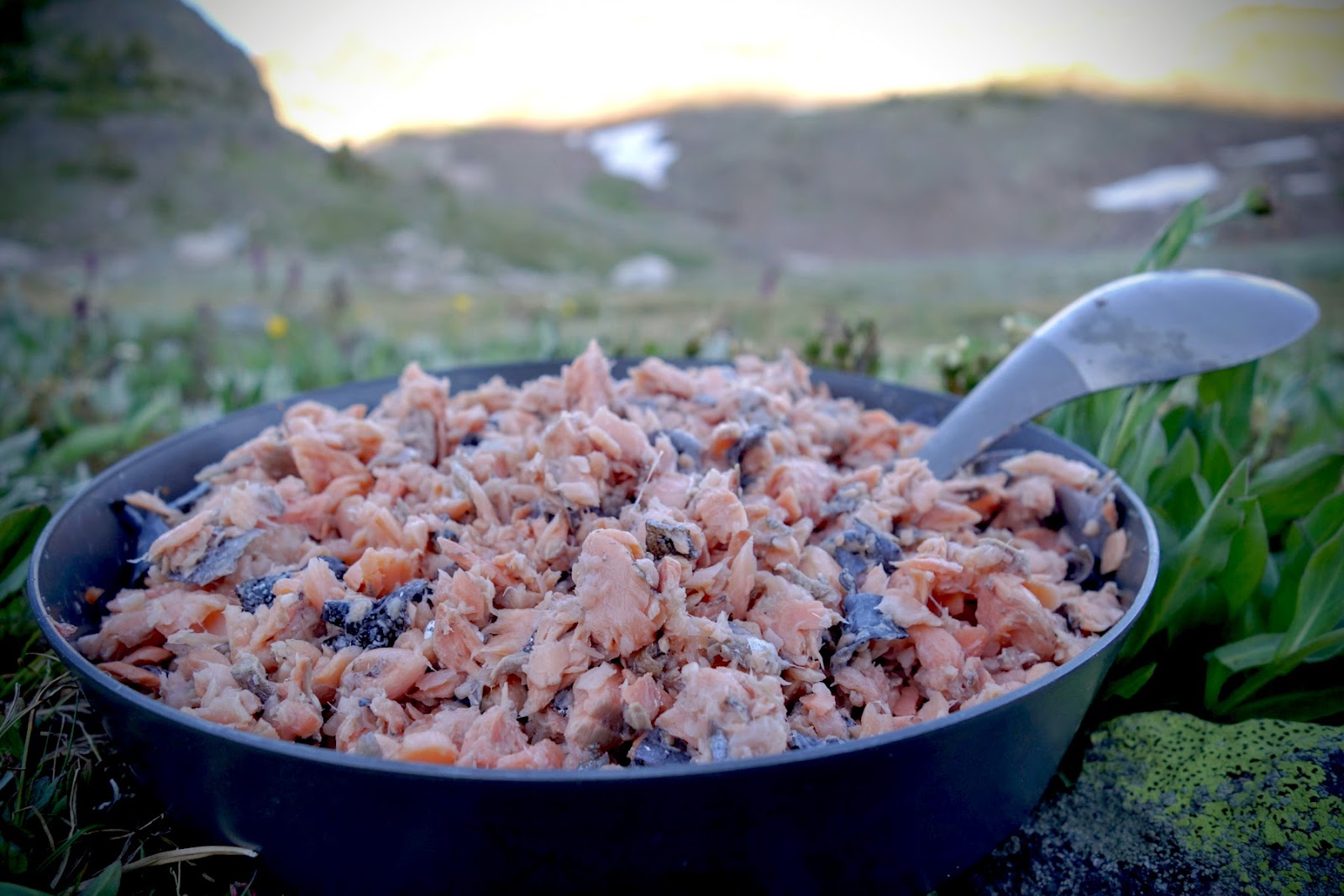
But fishing requires some additional gear and unique skills. A deeper skill set, and some experience, is essential if the backcountry traveler is going to rely upon it for part of their caloric sustenance.
That’s why debates about the practicality of fishing and its ability to reduce food weight are not uncommon within the community of enthusiasts who call themselves ultralight backpackers. Therefore, the primary purpose of this article is to explore the specific question: can backcountry fishing save carried food weight?
In order to answer this question, I’ll follow this process:
- Calculate the weight of backcountry fishing gear.
- Estimate the probability of catching and eating fish every day.
- Determine the macronutrient content of that fish.
- Evaluate how much carried food weight the caught fish can replace without sacrificing daily nutrition or calorie intake.
- Calculate the number of days required to get a return (eating caught fish) on investment (weight of carried fishing gear).
- Compare these results using conventional, light, and ultralight backcountry fishing kits.
How much does fishing gear weigh?
The basic elements of a fishing kit include the rod, the reel, line (including leader and tippet), and either bait, lures, or flies.
Conventional (Western) Fly Fishing Kit – 2 pounds
For the purpose of this article, we are going to focus on fly fishing. A conventional fly fishing kit includes a fly rod (which is protected in a cloth rod sleeve and carried in a rigid tube), a fly reel, backing line, the fly line, leaders, tippet spools, flies in a fly box, a vest, and a few tools (hemostats, nippers) and supplies (split shot, strike indicators, and floatant). In addition, it’s not uncommon for backcountry anglers to bring a landing net, but they rarely bring wading gear (e.g., waders, wading boots).
In most of my interviews with anglers who practice conventional western fly fishing into the backcountry, the following gear list is representative of their kits:
- Fly rod – 9 ft 5 wt 4pc carried in a cloth rod sock and metal rod tube – 16 oz
- Fly reel – 5 wt with fly line and backing – 5 oz
- Extra leaders and tippet spools – 3 oz
- Flies and boxes – 4 oz
- Tools – 2 oz
- Other supplies – 2 oz
Minimalist (Western) Fly Fishing Kit – 1 pound
A conventional western fly fishing kit can be lightened up by making a number of compromises that would be appropriate for most backcountry fisheries:
- Reduce the length and rated line weight of the rod.
- Reduce the size and line capacity of the fly reel.
- Reduce the length of the fly line and eliminate the backing.
- Replacing plastic fly boxes with foam fly boxes.
- Replacing the vest with a hip pack or other type of pouch for tackle storage.
- Eliminating the landing net.
- Replacing the stock metal rod tube with something less rigid, like a plastic shipping tube with vinyl end caps.
In my experience, I’ve been able to reduce the weight of a western fly fishing kit down to about 12-16 ounces, recognizing that such sacrifices result in the inability to fight extremely large trout, which fortunately, are not common in the backcountry. The reason for this is that I’m carrying a lighter rod, less line, and a smaller reel. In addition, there are some sacrifices made in fly boxes and fly selection, which to be honest, I’ve never found to limit my ability to catch enough fish in the backcountry for reliable meals.
Ultralight (Tenkara) Kits – 0.25 pounds
Finally, at the lighter end of the range, one can assemble a minimalist tenkara fishing kit, which eliminates the weight of a fly reel and fly line.
And at the ultralight end of the spectrum, a tenkara kit can be minimalized to an extreme by including only those essential items required to catch small to medium-sized trout – e.g., rod, line, tippet, and flies.
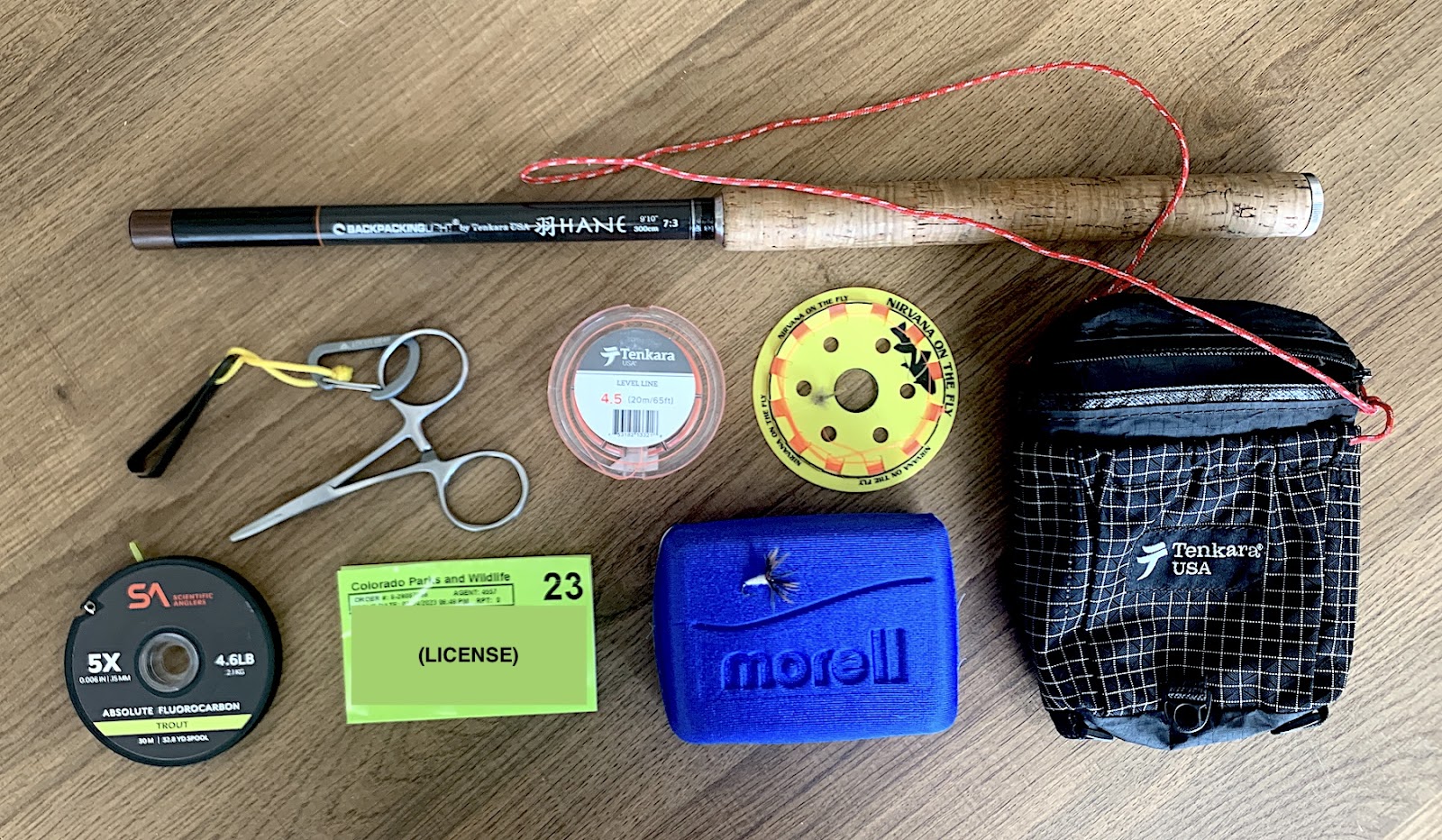
What is the probability of catching fish every day?
Whether or not you catch fish every day depends not only on you and your skill, but on the level of cooperation of the fish! Specifically, the probability that you catch a fish will depend on you finding the fish, the fish wanting to eat, and you being able to catch the fish.
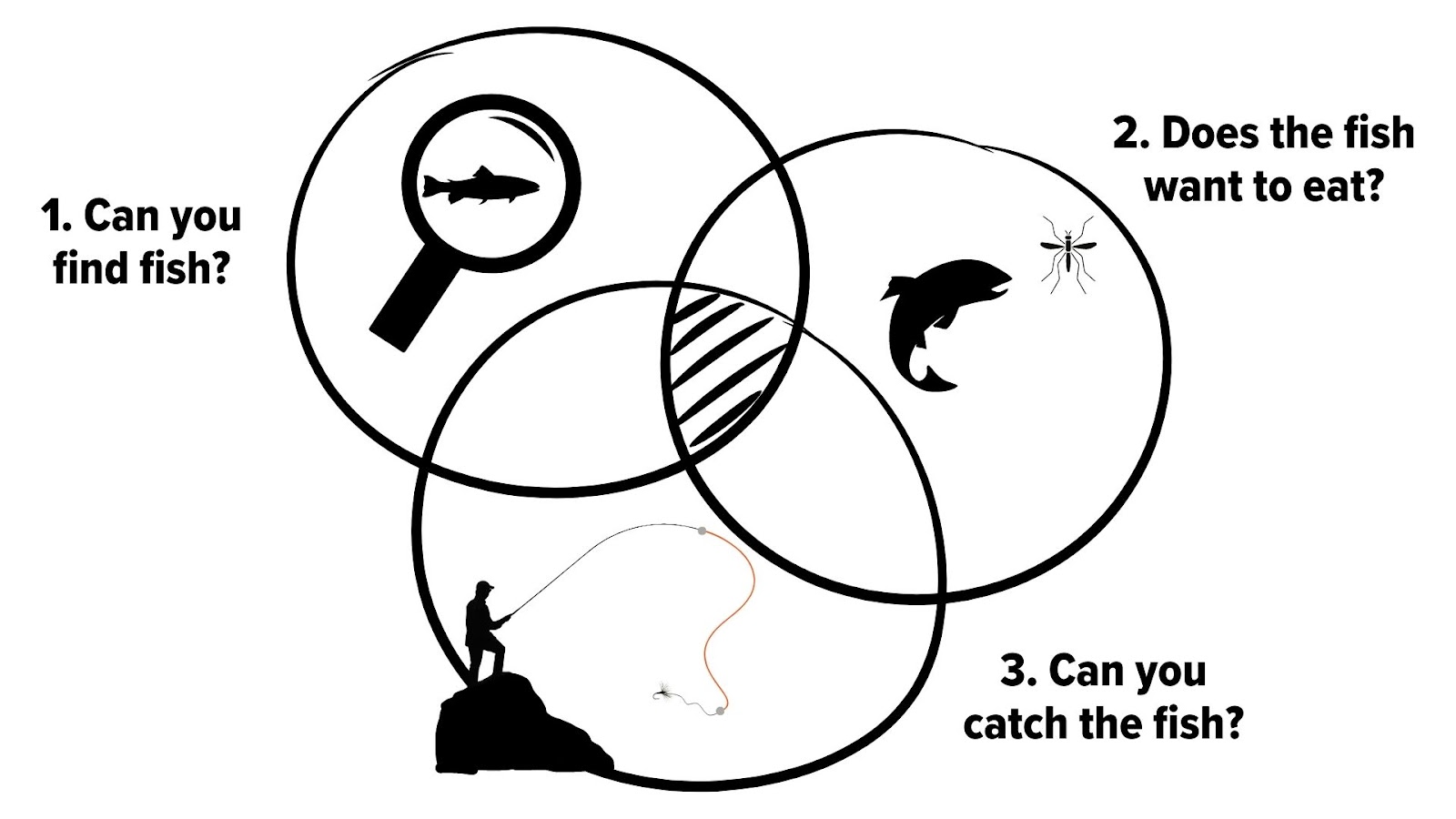
Whether or not you find fish depends in part on your skill, and in part on whether or not there are fish in the area where you are hiking. The latter can be mitigated by doing research prior to your trip. Fishing reports from local fly shops, trip reports from backcountry users, and stocking reports (or fish population inventories or surveys) from land and fisheries management agencies can all be used to determine which lakes and streams are most likely to support populations of fish. Once you have identified a water body that houses fish, then your skills come into play. Understanding where fish lie and feed in the waterbody makes your fishing efforts more efficient. Otherwise, you may just be casting into water in the hopes of catching a fish that may never show up.

Fish feed in response to a variety of conditions. Seasonality, environmental conditions and the activity of food sources are the two most important. Sunlight (or cloud cover), wind, barometric pressure, lunar phases, water temperature, and air temperature may have an impact on both the activity of food sources and whether or not fish will feed on them. In one of my favorite headwater streams in the Montana Beartooths, I know with almost absolute certainty that calm, sunny, fall afternoons result in a Dicosmoecus gilvipes (October Caddis) hatch that makes trout go into a feeding frenzy.
Finally, once you’ve found the fish and are confident that they’ll eat, you still have to present your line, leader, and fly to the fish so as not to spook it and have them sense that you’re a predator. And assuming you hook a trout that takes your fly, you have one more step ahead of you: land the fish so you know that it’s going to make it into your cooking pan!
How much nutrition does trout meat provide?
Now that you’ve caught your fish, let’s figure out how much nutrition it can provide. The following table shows the relationship between the size of a trout, how much edible meat can be harvested from it, and the macronutrient profile of that meat.
| Length (inches) | Weight (ounces) | Edible Meat Weight (ounces) | Protein (g) | Fat (g) | Carbohydrates (g) | Calories |
|---|---|---|---|---|---|---|
| 6 | 1.1 | 0.6 | 3.2 | 1.6 | 0 | 24 |
| 8 | 2.7 | 1.3 | 7.6 | 3.8 | 0 | 57 |
| 10 | 5.2 | 2.6 | 14.7 | 7.4 | 0 | 111 |
| 12 | 9 | 4.5 | 25.5 | 12.7 | 0 | 191 |
| 14 | 14.3 | 7.1 | 40.5 | 20.2 | 0 | 304 |
| 16 | 21.3 | 10.7 | 60.4 | 30.2 | 0 | 453 |
Assumptions:
- Weight is estimated based on the popular cubic formula used in fisheries science to estimate the weight of average-proportioned rainbow trout, i.e., weight (g) = 0.009 * length (cm) ^ 3.
- Edible meat weight is estimated as 50% of the total fish weight for trout.
- Macronutrient content is estimated as 20% protein, 10% fat, and negligible carbohydrates.
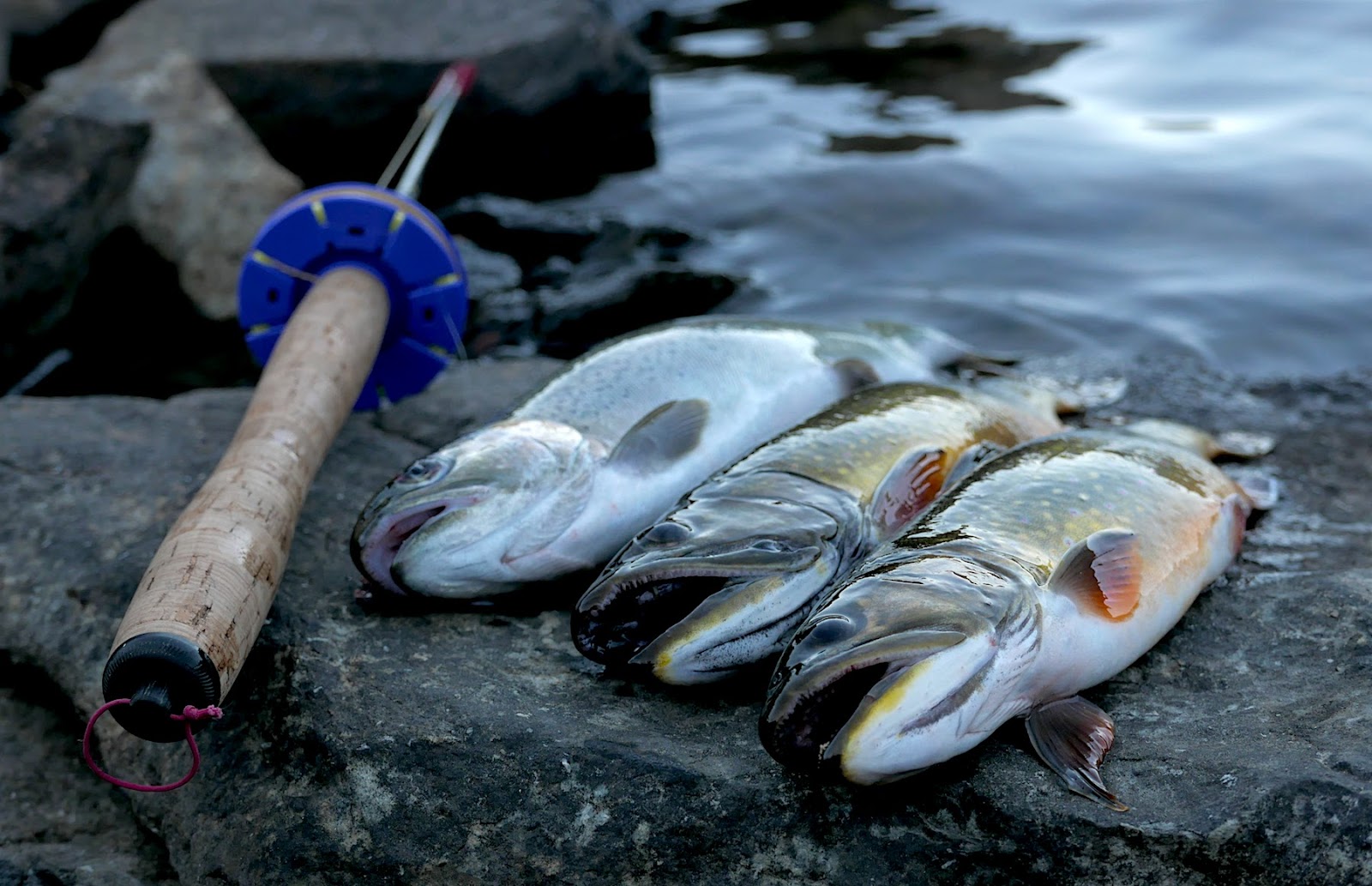
How much carried food weight can caught fish replace?
This question can be answered using the previous table (above) as a reference.
My normal backpacking diet has a caloric density of about 120 Calories per ounce, and a macronutrient profile of approximately 20% protein, 50% fats, and 30% carbohydrates.
For the purpose of this discussion, I’ll focus primarily on Calories. Since I’m consuming trout for only one meal of my day, I usually try to catch a hearty portion for a meal, i.e., four 10-inch fish (444 Calories) or some combination of larger and smaller trout that provide me with 400 to 500 Calories.
To keep the math simple, let’s assume I’m targeting 480 Calories for my trout meal. That means I might leave 480 Calories out of my packaged (dry) backpacking meals, which equates to about four ounces of dry food.
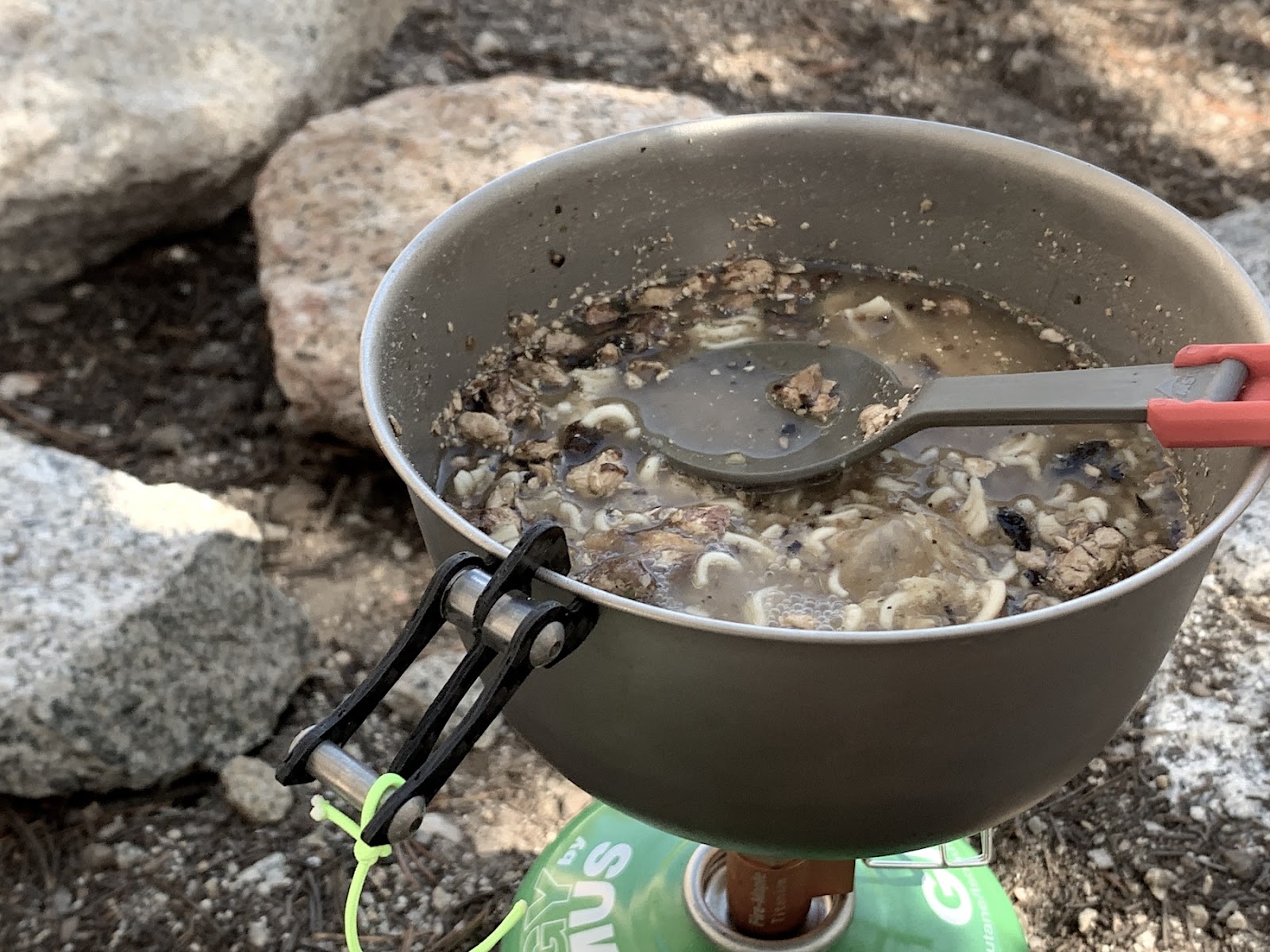
How many days of eating fish for one meal a day is required to get a return (eating caught fish) on investment (weight of carried fishing gear)?
The answer to that question depends on the weight of my fishing kit. Here’s a case study from a recent 10-day summer wilderness trek in Colorado, where I ate an average of one hearty trout meal per day (480 Calories).
My fishing kit included the following:
- tenkara rod – 2.7 oz
- line, tippet, fly on a card x 2 – 0.2 oz
- 5x tippet spool – 0.2 oz
- nippers / hemostats on neck cord – 1.3 oz
- foam box with flies – 1.0 oz
- tackle pouch – 1.1 oz
Summary:
- Total weight of fishing kit = 6.6 oz = 0.41 lb
- Total dry packaged food weight left behind = 9 days x 480 Calories/day / 120 Calories/ounce = 36 oz = 2.25 lb
- Total weight of spices and carbs (e.g., dry potatoes) added back for cooking fish = 1 oz/day x 9 days = 9 oz = 0.56 lb
Total Net Weight Savings = 0.41 lb + 0.56 lb – 2.25 lb = 1.28 lb

This is not a substantial amount of weight savings over the course of a 10 day trek. For sustenance alone, it would be somewhat difficult to justify. For the backcountry hiker that doesn’t find any entertainment or meditative value in fishing, the time spent fishing, dealing with gear, cleaning and cooking fish, etc., won’t be worth the savings of a pound or two.
However, it’s refreshing to discover that not only can you save pack weight by bringing a fishing kit, you can also have all of the benefits that come with fishing (as described in the introduction to this article).
Keep in mind that the analysis in this section involves a relatively lightweight kit based on a tenkara-style fishing rod. This, of course, is one of the most compelling reasons to fish tenkara in the backcountry.
The following chart illustrates a case study showing different starting pack weights for 3, 7, 14, and 21-day treks for different types of fishing kits.
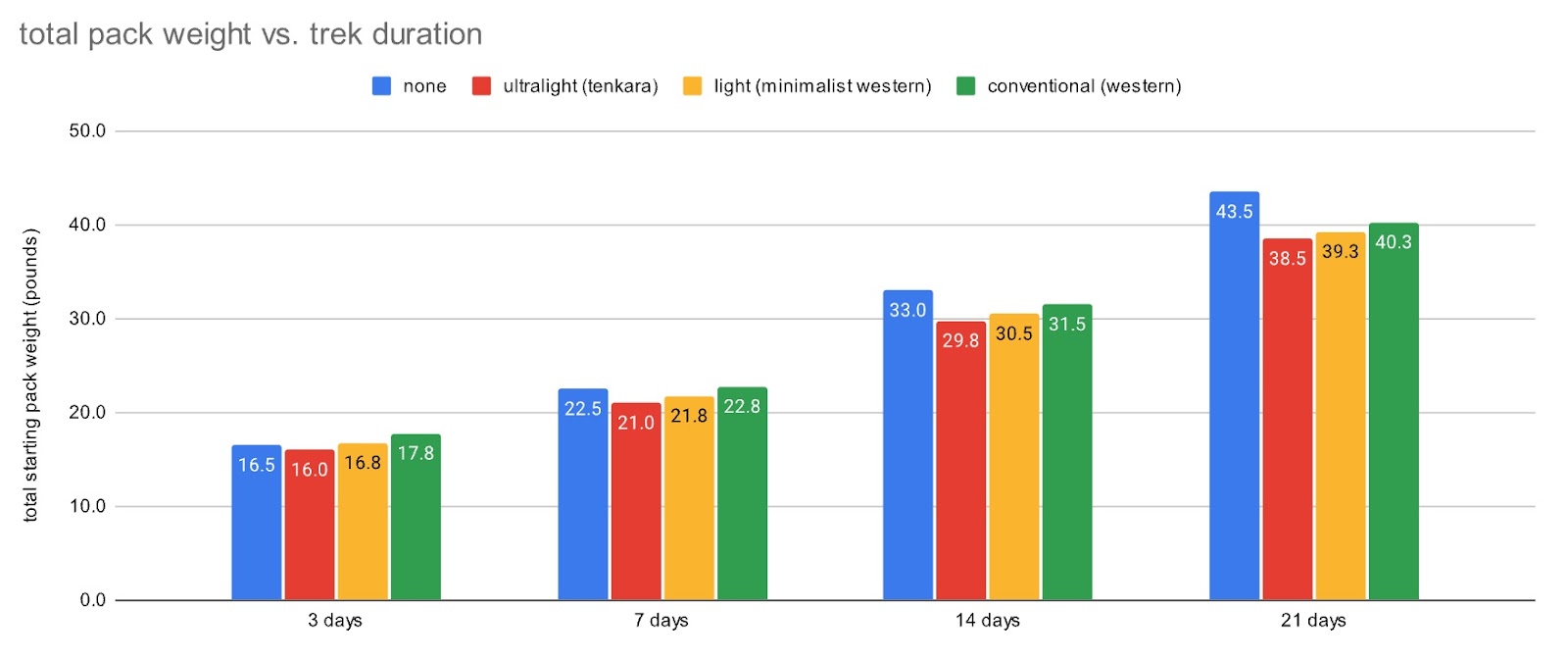
Assumptions:
- Base weight = 12 pounds.
- Fishing kit weights: none (0 pounds), ultralight (0.25 pounds), light (1.0 pounds), conventional (2.0 pounds).
- Food weight is 1.5 pounds per day for the case where no fishing kit is carried, and 1.25 pounds per day for the cases when a fishing kit is carried, based on the assumption that the angler will catch and consume approximately 480 Calories per day of fish, which would be equivalent to saving about 4 ounces per day of dry food (if average dry food caloric density is 120 Calories per ounce).
Conclusions from the chart above:
- The difference in total starting pack weight for non-fishing and fishing case studies increases as trek duration increases.
- For short trips (e.g., 3 days), only the ultralight (tenkara) fishing kit makes it worth the added weight of a fishing kit.
- For long trips (e.g., 21 days), carrying an ultralight (tenkara) fishing kit can save as much as five pounds off the total starting pack weight.
Conclusion
Fishing isn’t for everyone. In terms of a backcountry activity, fishing is similar to photography or painting or climbing a snowy couloir in that it may (or may not) be the primary focus of a backcountry expedition, but requires additional gear to enjoy the activity.
However, unlike other ancillary backcountry activities, fishing has the potential to impact your pack weight by reducing the amount of carried food weight. The purpose of this article was to illustrate that point using a quantitative analysis.
For me, I’m a passionate fishing enthusiast, and am particularly passionate about tenkara-style fishing. Using an ultralight tenkara-style fishing kit allows me to not only enjoy that activity in the backcountry, but also to maximize the amount of benefit that comes from reducing carried food weight without adding much extra gear weight.
Finally, when thinking about the questions “can backcountry fishing save carried food weight?” and “can backcountry fishing provide me with a high level of enjoyment that makes it worth the weight of extra gear?” I always gravitate back toward the venn diagram above that asks:
- Can you find fish?
- Does the fish want to eat?
- Can you catch the fish?
Inherent in the answers to each of these three questions is the presumption that you have some level of skill as a backcountry angler. Gaining angling skills and experience can be difficult. Western fly fishing is intimidating, and requires an enormous amount of casting practice and study to be proficient at it. This is part of why I like tenkara fishing. It’s not only lighter, but it’s simpler and easier. In addition, the skills barriers required to become a very proficient tenkara angler come with less practice and less experience. This was a large part of my motivation to develop the new Backcountry Tenkara Masterclass. My hope is that experienced anglers see the benefits of tenkara and can transition quickly and easily, and that new anglers achieve tenkara casting and fishing skills quickly.

Recommendations
- Learn about tenkara gear, skills, and tactics in the new Backcountry Tenkara Fishing Masterclass
- Shop tenkara rods, lines, accessories, and flies at Tenkara USA
Related Content
- Article: Tenkara Fishing Rods and Gear for Backpacking
- Gear List: Tenkara Fly Fishing
- Podcast Episodes: Tenkara Fishing and the 12 Steps of Tenkara




Home › Forums › Can backcountry fishing save carried food weight?